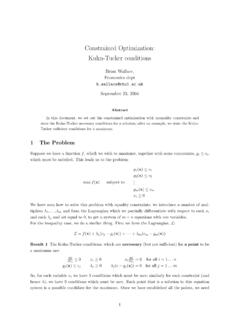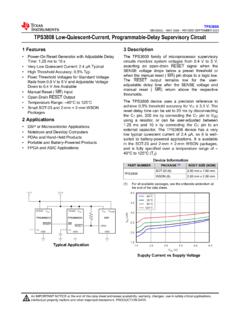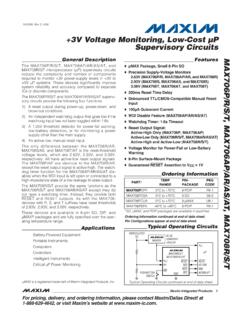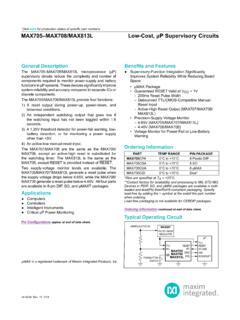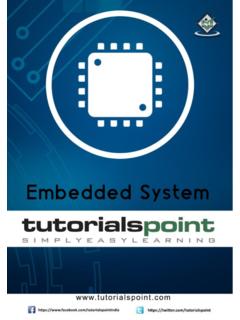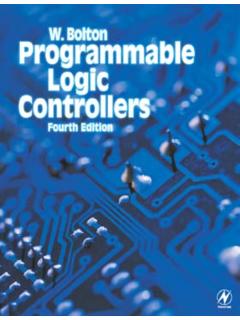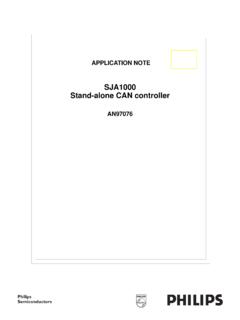Transcription of Basic Concepts of Microprocessors - cvut.cz
1 Basic Concepts of Microprocessors Differences between: Microcomputer a computer with a microprocessor as its CPU. Includes memory, I/O. etc. microprocessor silicon chip which includes ALU, register circuits & control circuits Microcontroller silicon chip which includes microprocessor , memory & I/O in a single package. What is a microprocessor ? The word comes from the combination micro and processor. Processor means a device that processes whatever. In this context processor means a device that processes numbers, specifically binary numbers, 0's and 1's. To process means to manipulate. It is a general term that describes all manipulation.
2 Again in this content, it means to perform certain operations on the numbers that depend on the microprocessor 's design. What about micro? Micro is a new addition. In the late 1960's, processors were built using discrete elements. These devices performed the required operation, but were too large and too slow. In the early 1970's the microchip was invented. All of the components that made up the processor were now placed on a single piece of silicon. The size became several thousand times smaller and the speed became several hundred times faster. The Micro Processor was born. Definition of the microprocessor The microprocessor is a programmable device that takes in numbers, performs on them arithmetic or logical operations according to the program stored in memory and then produces other numbers as a result.
3 Definition (Contd.). Lets expand each of the underlined words: Programmable device: The microprocessor can perform different sets of operations on the data it receives depending on the sequence of instructions supplied in the given program. By changing the program, the microprocessor manipulates the data in different ways. Instructions: Each microprocessor is designed to execute a specific group of operations. This group of operations is called an instruction set. This instruction set defines what the microprocessor can and cannot do. Definition (Contd.). Takes in: The data that the microprocessor manipulates must come from somewhere.
4 It comes from what is called input devices . These are devices that bring data into the system from the outside world. These represent devices such as a keyboard, a mouse, switches, and the like. Definition (Contd.). Numbers: The microprocessor has a very narrow view on life. It only understands binary numbers. A binary digit is called a bit (which comes from binary digit). The microprocessor recognizes and processes a group of bits together. This group of bits is called a word . The number of bits in a microprocessor 's word, is a measure of its abilities . Definition (Contd.). Words, Bytes, etc.
5 The earliest microprocessor (the Intel 8088 and Motorola's 6800) recognized 8-bit words. They processed information 8-bits at a time. That's why they are called 8-bit processors . They can handle large numbers, but in order to process these numbers, they broke them into 8-bit pieces and processed each group of 8-bits separately. Later Microprocessors (8086 and 68000) were designed with 16-bit words. A group of 8-bits were referred to as a half-word or byte . A group of 4 bits is called a nibble . Also, 32 bit groups were given the name long word . Today, all processors manipulate at least 32 bits at a time and there exists Microprocessors that can process 64, 80, 128 bits Definition (Contd.)
6 Arithmetic and Logic Operations: Every microprocessor has arithmetic operations such as add and subtract as part of its instruction set. Most Microprocessors will have operations such as multiply and divide. Some of the newer ones will have complex operations such as square root. In addition, Microprocessors have logic operations as well. Such as AND, OR, XOR, shift left, shift right, etc. Again, the number and types of operations define the microprocessor 's instruction set and depends on the specific microprocessor . Definition (Contd.). Stored in memory : First, what is memory? Memory is the location where information is kept while not in current use.
7 Memory is a collection of storage devices. Usually, each storage device holds one bit. Also, in most kinds of memory, these storage devices are grouped into groups of 8. These 8 storage locations can only be accessed together. So, one can only read or write in terms of bytes to and form memory. Memory is usually measured by the number of bytes it can hold. It is measured in Kilos, Megas and lately Gigas. A Kilo in computer language is 210 =1024. So, a KB (KiloByte) is 1024. bytes. Mega is 1024 Kilos and Giga is 1024 Mega. Definition (Contd.). Stored in memory: When a program is entered into a computer, it is stored in memory.
8 Then as the microprocessor starts to execute the instructions, it brings the instructions from memory one at a time. Memory is also used to hold the data. The microprocessor reads (brings in) the data from memory when it needs it and writes (stores) the results into memory when it is done. Definition (Contd.). Produces: For the user to see the result of the execution of the program, the results must be presented in a human readable form. The results must be presented on an output device. This can be the monitor, a paper from the printer, a simple LED or many other forms. A microprocessor -based system From the above description, we can draw the following block diagram to represent a microprocessor -based system: Input Output Memory Inside The microprocessor Internally, the microprocessor is made up of 3 main units.
9 The Arithmetic/Logic Unit (ALU). The Control Unit. An array of registers for holding data while it is being manipulated. Organization of a microprocessor - based system Let's expand the picture a bit. I/O. Input / Output ALU Register Array System Bus Control Memory ROM RAM. Memory Memory stores information such as instructions and data in binary format (0 and 1). It provides this information to the microprocessor whenever it is needed. Usually, there is a memory sub-system in a microprocessor -based system. This sub-system includes: The registers inside the microprocessor Read Only Memory (ROM). used to store information that does not change.
10 Random Access Memory (RAM) (also known as Read/Write Memory). used to store information supplied by the user. Such as programs and data. Memory Map and Addresses The memory map is a picture representation of the address range and shows where the different memory chips are located within the address range. 0000 0000. EPROM Address Range of EPROM Chip 3 FFF. 4400. RAM 1 Address Range of 1st RAM Chip Address Range 5 FFF. 6000. RAM 2 Address Range of 2nd RAM Chip 8 FFF. 9000. RAM 3 Address Range of 3rd RAM Chip A3FF. A400. RAM 4 Address Range of 4th RAM Chip F7FF. FFFF. Memory To execute a program: the user enters its instructions in binary format into the memory.
